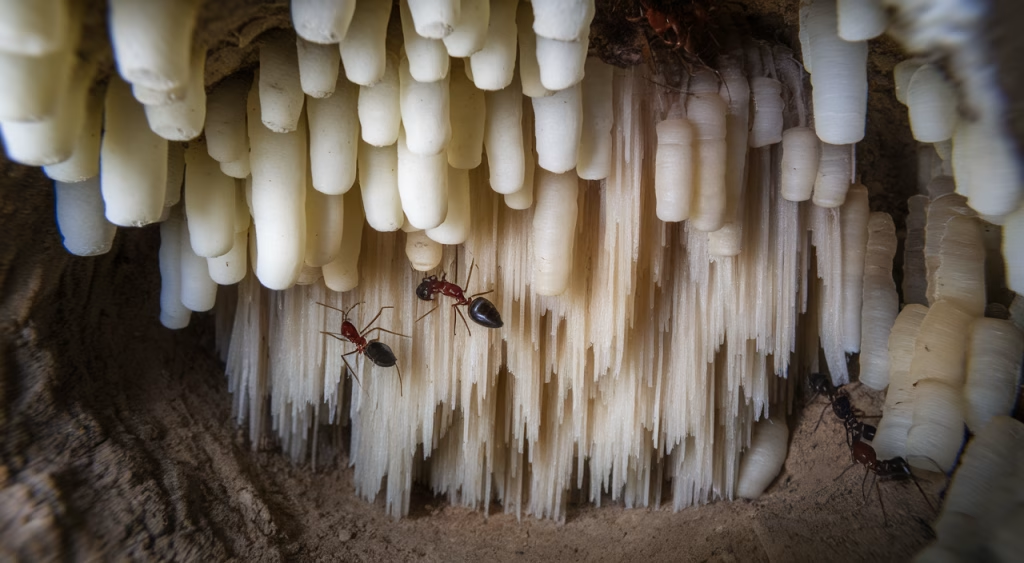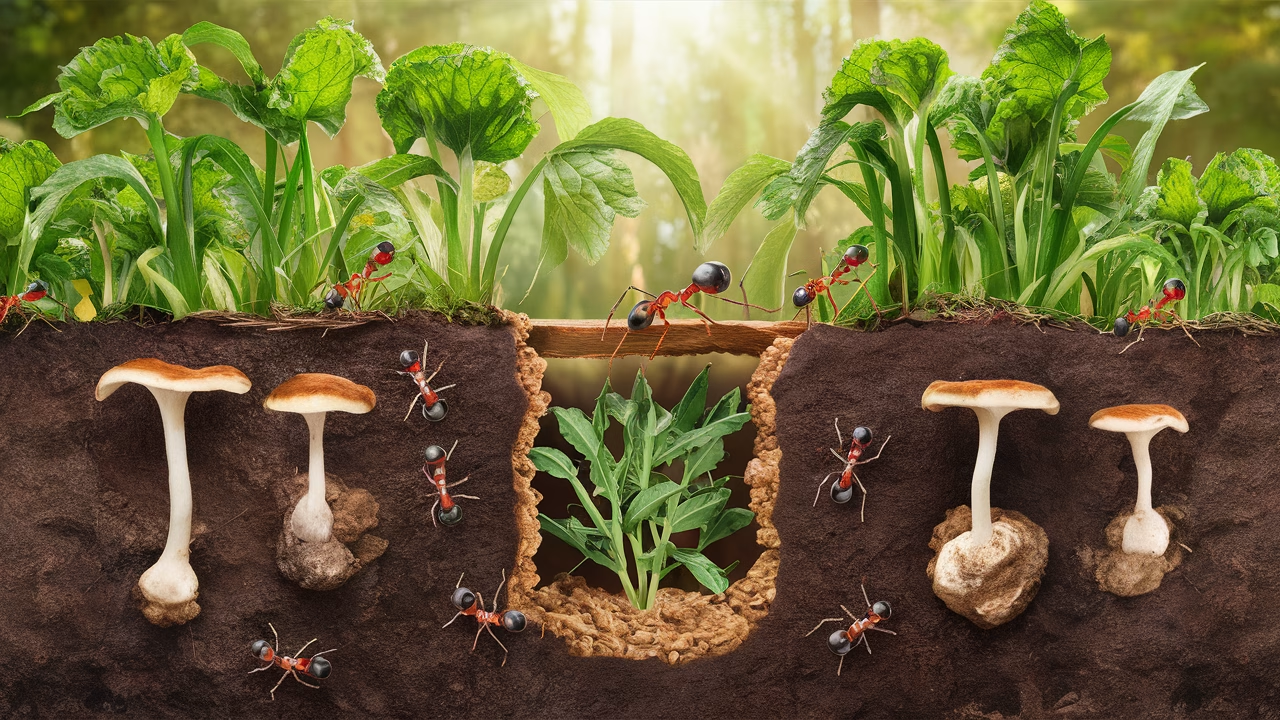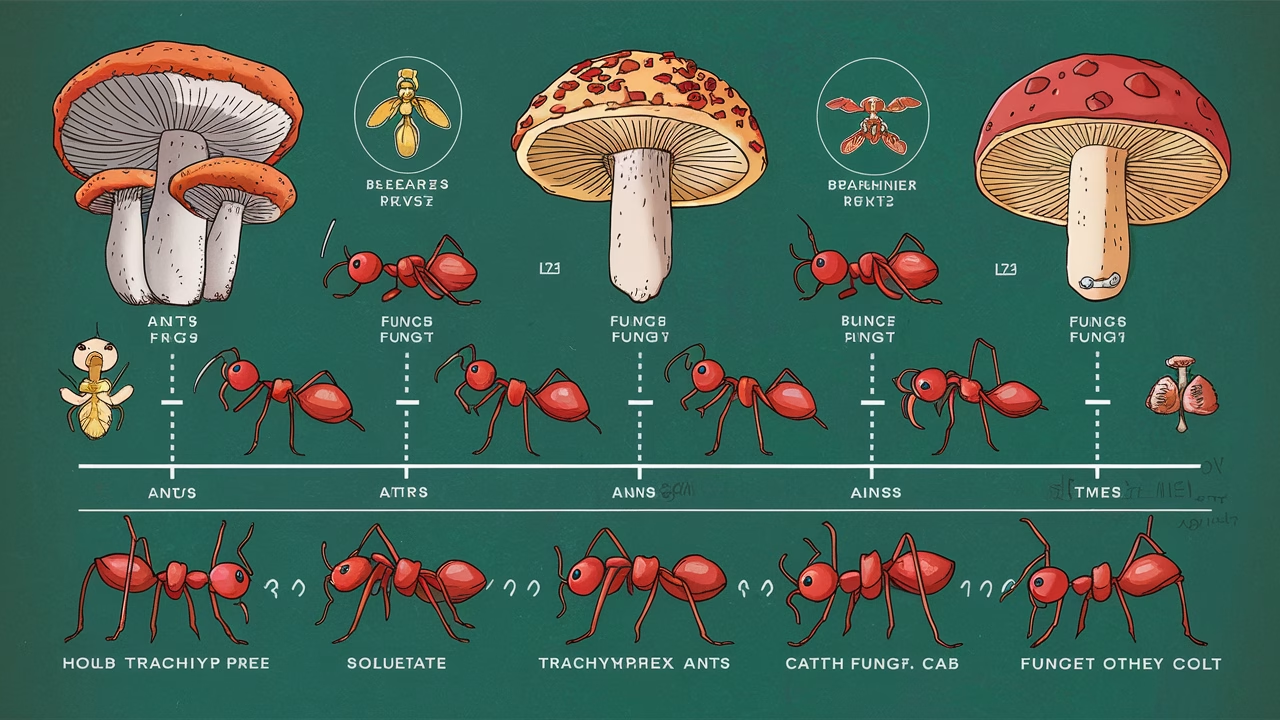How do ants farm fungi underground, and why is this behavior important to ecosystems?
When you think about how ants farm fungi underground, you’re witnessing one of nature’s most sophisticated agricultural systems. Trachymyrmex ants and related species have perfected underground fungus cultivation over millions of years, creating intricate fungus gardens that serve as the foundation of thriving underground ecosystems. This symbiotic relationship between ants and fungi isn’t just fascinating—it’s essential for soil health and biodiversity in countless habitats worldwide.
- TL;DR — Quick Summary
- Ants farm fungi underground by cultivating specific fungal species in carefully maintained subterranean chambers.
- Trachymyrmex ants are master cultivators, feeding their fungus gardens with processed plant material to create sustainable food sources.
- Fungus gardens function as sophisticated agricultural systems with controlled microclimates and precise maintenance routines.
- These operations create vital underground ecosystems that influence soil health and support diverse organisms.
- The symbiotic relationship between ants and fungi demonstrates millions of years of co-evolution and mutual dependence.
- Understanding “How do ants communicate within underground fungus gardens” reveals complex chemical signaling systems.
Introduction: Discovering the Symbiotic Relationship Between Ants and Fungi
Beneath your feet lies a hidden world where ants farm fungi underground with precision that rivals human agriculture. While you might notice ants marching across sidewalks, the real action happens in humid underground chambers where Trachymyrmex ants tend their precious fungus gardens with meticulous care.
This remarkable symbiotic relationship between ants and fungi has evolved over 50 million years, creating one of nature’s most successful farming partnerships. These underground ecosystems operate like miniature agricultural complexes, where ants provide cultivation services while fungi supply nutrition for entire colonies. The benefits of fungal farming for Trachymyrmex ants extend far beyond simple food production—they’ve created sustainable underground civilizations.
Let’s explore how these tiny farmers transform soil into thriving agricultural systems that support complex underground ecosystems.
The Role of Trachymyrmex Ants in Fungal Farming
Trachymyrmex ants represent the perfect example of how ants farm fungi underground through sophisticated agricultural practices. These medium-sized fungus-farming ants, found throughout the Americas, have developed specialized techniques that demonstrate the evolutionary role of ants in maintaining underground fungi populations.
1. Preparing Nutritious Substrates
Trachymyrmex ants collect diverse plant materials—fallen leaves, flower petals, and organic debris—which they process into nutrient-rich substrates for their fungus gardens. Worker ants carefully chew this material into mulch-like consistency, creating the perfect growing medium for their fungal partners. This preprocessing is crucial for the benefits of fungal farming for Trachymyrmex ants to be realized.
2. Establishing Fungal Colonies
When founding new colonies, queen ants carry fungal cultures from their parent colony, ensuring genetic continuity in their underground ecosystems. This starter culture—essential for the symbiotic relationship between ants and fungi—cannot survive independently, making this partnership obligate for both species.
3. Maintaining Underground Agriculture
Trachymyrmex ants continuously monitor their fungus gardens, removing contaminants, regulating moisture, and harvesting nutrient-rich fungal growths. This constant maintenance ensures their underground ecosystems remain productive and healthy, supporting entire colonies through sustainable agriculture.
Understanding Underground Fungus Gardens
The architecture of fungus gardens reveals how ants farm fungi underground through sophisticated environmental engineering. These underground ecosystems function as climate-controlled agricultural facilities where every detail supports optimal fungal growth.
The Architecture of Underground Agriculture
Fungus gardens occupy specially constructed chambers within complex tunnel systems. These underground spaces feature ventilation shafts, humidity control, and waste management systems that rival human agricultural infrastructure. The evolutionary role of ants in maintaining underground fungi is evident in every architectural detail designed to support fungal cultivation.
Daily Operations in Fungus Gardens
Worker ants maintain strict schedules in their underground ecosystems, with different castes handling foraging, substrate preparation, garden maintenance, and harvesting. Younger workers typically manage internal fungus gardens, while experienced foragers gather materials from the surface world.
Communication Systems Below Ground
How do ants communicate within underground fungus gardens? Through sophisticated chemical signaling systems using pheromones, tactile cues, and vibrations. These communication methods coordinate activities across multiple chambers, ensuring efficient operation of their underground agricultural systems.
Evolutionary Significance of Ant-Fungi Symbiosis
The evolution of how ants farm fungi underground represents one of biology’s most successful mutualistic partnerships. This symbiotic relationship between ants and fungi has shaped both species over millions of years, creating the foundation for diverse underground ecosystems.
Mutual Benefits Drive Evolution
The benefits of fungal farming for Trachymyrmex ants include reliable nutrition, reduced foraging risks, and sustainable food production. Meanwhile, fungi receive protection, optimal growing conditions, and dispersal services. This mutual dependency strengthens the evolutionary role of ants in maintaining underground fungi populations.
Diversification Through Partnership
Fungus-farming ants diverged from predatory ancestors approximately 55 million years ago, developing increasingly sophisticated underground ecosystems. Trachymyrmex ants evolved intermediate complexity, balancing efficiency with environmental adaptability in their fungus gardens.
Ecosystem-Level Impacts
As ants farm fungi underground, they create cascading effects throughout their environment. Soil aeration, nutrient cycling, and microhabitat creation support diverse underground ecosystems that extend far beyond the immediate fungus gardens, influencing entire ecological communities.
Effects of Human Interference on Ant-Fungi Ecosystems
Human activities increasingly threaten the delicate underground ecosystems where ants farm fungi underground. Agricultural expansion, chemical applications, and climate change disrupt the environmental conditions necessary for successful fungus gardens.
Threats to Fungal Diversity
Many fungal strains cultivated by Trachymyrmex ants exist nowhere else in nature and cannot survive without ant cultivation. When colonies are destroyed, these unique genetic resources disappear permanently, reducing the biodiversity of underground ecosystems.
Climate Change Challenges
Shifting temperature and precipitation patterns disrupt the precisely controlled conditions in fungus gardens. The symbiotic relationship between ants and fungi becomes stressed when environmental parameters fall outside optimal ranges, leading to colony failures.
Conservation Priorities
Protecting underground ecosystems requires comprehensive approaches that preserve not only ant populations but entire fungal-farming communities. Understanding how ants communicate within underground fungus gardens helps conservation efforts maintain these critical agricultural partnerships.
Frequently Asked Questions
- What type of fungi do ants farm?
Fungus-growing ants cultivate species from the Leucocoprinus and related genera, which are highly specialized and dependent on their ant hosts. - Do all ants grow fungi?
No. Only certain tribes, like Attini, which includes Trachymyrmex and Atta ants, have evolved fungal cultivation behaviors. - How do ants protect their fungus gardens from disease?
They use antimicrobial secretions, meticulously clean chambers, and remove infected substrate or diseased fungi immediately. - What happens if the fungus dies?
The colony may attempt to restart cultivation using backup spores or, if unsuccessful, may collapse entirely due to starvation. - Why can’t farmed fungi survive without ants?
These fungi have evolved to depend on ant care—similar to how domesticated crops rely on humans and can’t propagate effectively in the wild.





